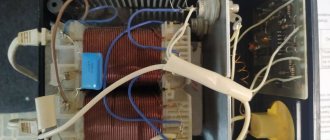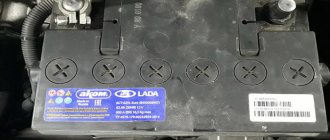Battery voltage under load
The battery voltage under load will be lower than at rest. This indicator can also be used to judge the health of the battery.
If, after connecting the load plug, the control device shows less than 9 V, then the battery is discharged and needs to be charged. If after repeating the procedure the situation does not change, the battery will need to be replaced with a new one in the near future.
If it is not possible to use a load fork to test the battery under load, then you can use a digital multimeter and turn on the engine starter as a load.
If the voltage in the on-board network drops below 9 V when the starter is turned on, then in this case you will also need to charge the battery using a charger. It is also worth checking the wiring elements and electrical consumers for serviceability.
If there is no electrical leakage in the system, and an excessive voltage drop is observed again with a fully charged battery, then the battery should be replaced.
If powerful consumers of electricity are not connected to the battery, then the voltage under light load will not change too much.
How to set the electrolyte level
It is possible to check the level only in serviced batteries. It is strongly recommended not to tamper with the integrity of the casing of a maintenance-free battery to perform unintended “maintenance.”
If the battery is serviceable, it needs to be removed, cleaned of dirt and the plugs unscrewed. The level is measured using a special tube with a millimeter scale. It is lowered into the jar until it comes into contact with the upper plate of the separator; the hole at the top is clamped with a finger. When pulling out, you can easily determine the electrolyte level. It should not be less than 10 mm. If the electrolyte level is less than the specified value, you need to determine the reason for its decrease. It usually falls due to normal boiling and evaporation. In this case, you just need to add distilled water to the jars.
If the level has decreased due to electrolyte spillage, you need to add ready-made electrolyte. After topping up, the battery must be recharged.
Battery voltage without load
The voltage of the battery, to which no electricity consumers are connected, is 12.6 - 12.8 V. If the voltage at rest is less than this indicator, this will indicate that the battery is discharged or there is a short circuit in some banks.
Operating a battery with a reduced charge level will certainly lead to the formation of lead sulfate on the plates, which will cause a significant drop in the capacity of the device.
To accurately measure the battery voltage without load, be sure to remove the terminals from the battery terminals immediately before connecting the measuring device.
Why is this happening
Any battery has a certain resource, even with timely maintenance. Modern batteries, depending on operating conditions, can last from 3 to 7 years. After this period, the car battery voltage gradually begins to decrease. This is due to the destruction of lead plates, which, unfortunately, cannot be avoided over time. Of course, you can try to restore the battery, but it will no longer work like a new one.
If the generator malfunctions, the charging voltage of the car battery jumps, drops, or is completely absent. In this case, the battery operates in emergency mode, which can lead not only to its discharge, but also to its failure.
Current leakage is one of the main reasons for battery discharge. It is easily determined using an ammeter or multimeter turned on in its mode. By measuring the current between the removed ground terminal and the negative terminal of the battery, we determine the amount of leakage. If it is higher than 80 mA, you should immediately contact the service to find the leak and fix the problem.
Often, car owners independently install additional electrical appliances (speakers, subwoofers, lighting elements, various electronic devices), without even realizing that they significantly exceed the network load specified by the car’s passport data. This inevitably leads to the fact that the generator can no longer cope with this load, and part of it is covered by the battery.
It happens that unlucky drivers, sometimes leaving the car, simply forget to turn off the headlights, radio, interior lighting or other devices that consume electricity. This inattention also causes the battery to drain quickly.
A battery that is not serviced on time will also never work for long. Even if your car has a maintenance-free battery, you need to constantly look after it and periodically charge it.
Charged battery voltage
If the battery is fully charged, the voltage will depend on the battery model. If a regular antimony battery is used, then the minimum value of this indicator should be 12.6 V.
For a calcium battery, this indicator may be slightly higher, and at the terminals of a gel battery, this parameter should not fall below 13 V. If this indicator deviates from the norm, the battery must be charged with a current equal to 10% of the battery capacity.
If the battery voltage is measured while the engine is running, the readings from the device will be significantly higher. With a working battery and relay regulator, the voltage at the terminals can reach a maximum value of 14 V.
How to charge the battery
There are four ways to charge the battery. Each of them has its own advantages and disadvantages. Let's look at them.
- Constant current charging method. The only drawback is constant control over the process. Its essence lies in the fact that the charger sets a current equal to a tenth of the rated capacity of the battery. Charging takes 20 hours. Due to the fact that the battery, while charging, will gain current, the charging current will decrease, so it needs to be adjusted every 1.5-2 hours.
- Constant voltage charging method. This method also involves a charging process during the day. Here it is necessary to take into account that the charging voltage of the car battery will depend on the amount of voltage supplied. For example, with continuous charging at 14.5 V for 24 hours, the battery will be charged only 75-80%, at 15 V - about 90%, and only at 16.3-16.5 V will the battery be fully charged. This method is considered the safest and most effective.
- Combined method. To charge using this method, you will need a special charger. The process is fully automated and requires neither control nor presence. Simply connect the terminals and turn on the device. When the vehicle's battery reaches normal voltage during charging, the device will turn off automatically.
- Fast charging. This method is not recommended for use under normal conditions. It is used in extreme cases when the battery needs to be charged as quickly as possible. To do this, the device sets the maximum current with which the battery should be charged for no more than 20 minutes. Of course, we are not talking about full charging here, but this will be enough to start the engine.
Normal battery voltage
The normal battery voltage is an indicator that is displayed in the documentation for the power source. If, when purchasing a new battery, it is not possible to charge it to the value specified in the instructions, then such a malfunction will be a warranty case.
If the relay-regulator and generator on the car are working properly, then the battery will be automatically charged to a normal level during operation of the car. It is advisable to strive to use the battery throughout its entire service life only when there is normal voltage at the terminals.
With significant deviations of this parameter downward in the winter, the electrolyte in a discharged battery may completely freeze, and in the summer the lead plates will deteriorate more intensively.
| Charge level of antimony and hybrid batteries at voltage in Volts | |||||
| Electrolyte temperature | 100% | 75% | 50% | 25% | 0% |
| 48,9 | 12,663 | 12,463 | 12,253 | 12,073 | 11,903 |
| 43,3 | 12,661 | 12.,461 | 12,251 | 12,071 | 11,901 |
| 37,8 | 12,658 | 12,458 | 12,248 | 12,068 | 11,898 |
| 32,2 | 12,655 | 12,455 | 12,245 | 12,065 | 11,895 |
| 26,7 | 12,650 | 12,45 | 12,240 | 12,060 | 11,890 |
| 21,1 | 12,643 | 12,443 | 12,233 | 12,053 | 11,883 |
| 15,6 | 12,634 | 12,434 | 12,224 | 12,044 | 11,874 |
| 10 | 12,622 | 12,422 | 12,212 | 12,032 | 11,862 |
| 4,4 | 12,606 | 12,406 | 12,196 | 12,016 | 11,846 |
| -1,1 | 12,588 | 12,388 | 12,178 | 11,998 | 11,828 |
| -6,7 | 12,566 | 12,366 | 12,156 | 11,976 | 11,806 |
| -12,2 | 12,542 | 12,342 | 12,132 | 11,952 | 11,782 |
| -17,8 | 12,516 | 12,316 | 12,106 | 11,926 | 11,756 |
| Charge level for Calcium, AGM and GEL batteries at voltage in Volts | |||||
| Electrolyte temperature | 100% | 75% | 50% | 25% | 0% |
| 48,9 | 12,813 | 12,613 | 12,416 | 12,013 | 11,813 |
| 43,3 | 12,811 | 12,611 | 12,411 | 12,011 | 11,811 |
| 37,8 | 12,808 | 12,608 | 12,408 | 12,008 | 11,808 |
| 32,2 | 12,805 | 12,605 | 12,405 | 12,005 | 11,805 |
| 26,7 | 12,8 | 12,6 | 12,4 | 12,0 | 11,8 |
| 21,1 | 12,793 | 12,593 | 12,393 | 11,993 | 11,793 |
| 15,6 | 12,784 | 12,584 | 12,384 | 11,984 | 11,784 |
| 10 | 12,772 | 12,572 | 12,372 | 11,972 | 11,772 |
| 4,4 | 12,756 | 12,556 | 12,356 | 11,956 | 11,756 |
| -1,1 | 12,738 | 12,538 | 12,338 | 11,937 | 11,738 |
| -6,7 | 12,716 | 12,516 | 12,316 | 11,916 | 11,716 |
| -12,2 | 12,692 | 12,492 | 12,292 | 11,892 | 11,692 |
| -17,8 | 12,666 | 12,466 | 12,266 | 11,866 | 11,666 |
Discharged battery voltage
If the battery voltage is less than 11.6 V, then the battery is considered completely discharged. In this case, the operation of the electricity source is impossible and to restore its functionality you will need to use a charger operating from a 220 V network.
Almost all lead batteries are sensitive to full discharge. Calcium acid batteries can lose a significant part of their capacity even after a single deep discharge. The antimony device has great tolerance. Gel and AGM batteries are the most resistant to full discharge.
Battery voltage in winter
In winter, constant undercharging of the battery can lead to a significant decrease in the density of the electrolyte, as a result of which the liquid inside the cans can freeze. Freezing of the electrolyte, in many cases, leads to complete inoperability of the power source. To prevent this from happening in winter, there must be at least 12.5 V at the terminals.
If a serviceable battery model is in use, the battery charge level can be monitored without using a voltmeter. It is enough to regularly measure the density of the electrolyte, which should be about 1.28 g/cm3 for a fully charged battery.
Is it possible to start a car with a cordless screwdriver?
This method is adventurous. And it’s applicable when there are no other options left—there’s no charged battery at hand, no booster, no one has a “light.”
We remove the battery from the screwdriver, attach suitable contacts, and attach it to the standard battery terminals of the car. Don't get your hopes up: the starter won't even twitch. The only thing you can count on is to push the car. Perhaps the screwdriver battery has enough energy to revive the motor.
To light the cigarette, you can use a cordless screwdriver or impact wrench. Only the voltage of its battery should not be higher than 14 V.
To light the cigarette, you can use a cordless screwdriver or impact wrench. Only the voltage of its battery should not be higher than 14 V.
Important:
Be sure to check the supply voltage of the screwdriver. If 12 or 14 V, connect safely. And with 18-volt it’s not even worth trying. We conducted an experiment: we tried to start the car with an 18-volt lithium-ion battery. To reduce the voltage at least a little, the headlights were turned on before connecting the screwdriver battery. The engine was started from the pusher, but the lamps in the headlights burned out. But a more important and expensive part could have burned out!
Dependence of voltage on electrolyte density
The battery charge level directly depends on the density of the electrolyte. If the battery is serviceable, then the charge level can be measured quite accurately without using a tester.
Using a hydrometer, density is measured by taking a small amount of electrolyte from each jar of the device. The maximum density of the mixture of sulfuric acid and water in a fully charged battery is 1.3 g/cm3.
This indicator should be adhered to if the machine is operated in the cold. In summer, it can operate batteries with a density of 1.26 g/cm3 and higher. If the density of the electrolyte is within these limits, then the voltage at the terminals will be about 12.7 V. As the density drops, there is a proportional decrease in the potential difference at the battery terminals.
This indicator can decrease especially strongly if there are leaky places in the battery case through which some of the electrolyte will leak out. The electrolyte level can be restored by adding distilled water.
Visual inspection of the battery
The first thing you can do to determine whether the battery is working is to inspect it. Appearance can tell a lot.
Dirt mixed with moisture and automotive fluids on the terminals is an unacceptable phenomenon. It leads to oxidation of metal parts and loss of electrical contact. As a result, at best, we can get a self-discharge, at worst, a short circuit. If the battery is dirty, take the time to check the self-discharge current to make sure that it is necessary to maintain cleanliness under the hood. To do this, take an ammeter, disconnect the wires from the battery, touch one of the terminals with one probe, and simply run the other along the battery body. The value indicated on the ammeter screen will be the self-discharge current.
Next, take a look at the battery case. The presence of cracks and drips on it indicates mechanical damage, which caused the leakage of electrolyte. If this happens, it is no longer advisable to use this battery. When there are leaks from under the plugs, it is necessary to check the amount of electrolyte in each of the cans and eliminate the reason for its pouring out.
How to check battery voltage with a multimeter
You can measure the operating voltage at the battery terminals using a voltmeter, which is one of the functions of a multimeter.
The battery is a source of direct current, so before starting measuring work, the device should be set to the “DC” position. You should also set the voltage limit to 20V to allow more accurate measurements.
After proper preparation of the measuring device, it will be enough to connect the black probe to the minus, and the red one to the plus of the battery, so that the device shows the DC voltage. If you mix up the probes, the value will be negative.
Still have questions about battery voltage or have something to add? Then write to us about it in the comments, this will make the material more useful, complete and accurate.
Measuring Tools
Multimeter
To measure the voltage of a car battery, you will need an ordinary voltmeter, but it is best to use a multimeter - a multifunctional device that measures direct and alternating voltage, resistance and changes in direct current.
A multimeter allows you to check not only voltage, but also current leakage. Such a device can come in handy more than once when working with electrical devices; moreover, it is inexpensive and is sold in any electronics stores.
Before taking measurements, the battery terminals will need to be cleaned of accumulated dust and dirt, and the battery itself will need to be removed from the car. All further manipulations will be carried out either at home or in the garage - wherever is more convenient.
On the multimeter, you need to enable the corresponding mode, setting the value to 20 V. Next, you need to connect the black probe to the negative terminal, and the red probe to the positive terminal. After this, the voltage value will be displayed on the multimeter screen. Nothing critical will happen if the wires are mixed up - no information will simply appear on the display.
Important! Measuring in this way will not provide information about the performance of the battery - for this it is necessary to additionally apply a load.











